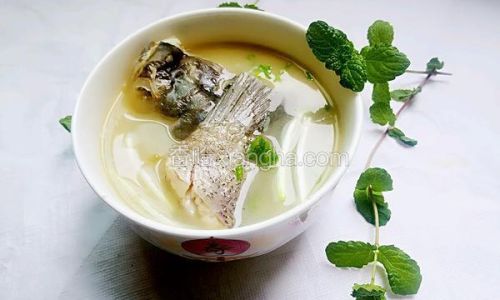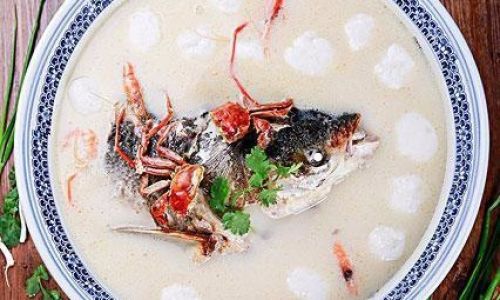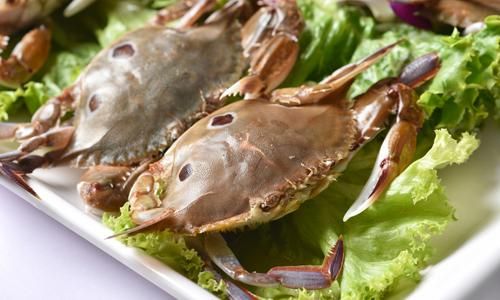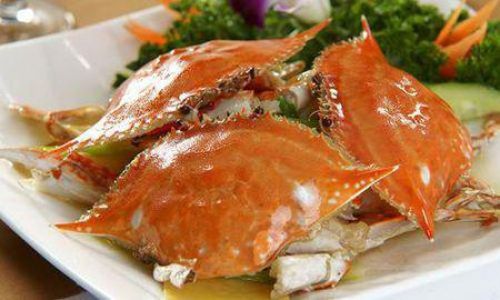Introduction
Silver carp, scientifically known as Hypophthalmichthys molitrix, is a freshwater fish widely found in Asia, particularly in China, Vietnam, and India. Its delicate flavor and firm texture make it an excellent choice for various culinary preparations, including soups. Silver carp soup is a dish cherished for its rich taste, nutritional benefits, and ability to warm the soul on cold days. This comprehensive guide will teach you how to make a delicious silver carp soup from scratch, ensuring every step is detailed and easy to follow, even for those with limited cooking experience.

Understanding Silver Carp
Before diving into the recipe, it’s essential to understand the basics of silver carp. This fish is known for its large scales, which can sometimes be a bit challenging to remove, but the effort is worth it due to its mild, slightly sweet flavor. Silver carp is rich in omega-3 fatty acids, protein, vitamins, and minerals, making it a healthy addition to your diet.
When selecting silver carp for your soup, look for fish with firm flesh, bright eyes, and red gills. Avoid fish with a strong odor or slimy texture, as these are signs of freshness. Fresh silver carp should be scaled, gutted, and cleaned properly before cooking.
Ingredients and Tools Preparation
Before starting, gather all the necessary ingredients and tools to ensure a smooth cooking process. Here’s a list of what you’ll need:
Ingredients:
- 1 whole silver carp (cleaned and scaled)
- 4 cups of water or fish stock
- 1 medium onion (sliced)
- 3 cloves of garlic (minced)
- 1-inch piece of ginger (sliced thinly)
- 2 green onions (chopped)
- 2 carrots (sliced into rounds)
- 1 celery stalk (sliced)
- 1 tomato (diced)
- 2 tablespoons of soy sauce
- 1 tablespoon of fish sauce (optional)
- 1 teaspoon of salt (adjust to taste)
- 1/2 teaspoon of white pepper (adjust to taste)
- 1/4 teaspoon of sugar (optional, to balance flavors)
- Fresh cilantro for garnish (optional)
- Lime wedges for serving (optional)
Tools:
- A sharp knife for cleaning and cutting the fish
- A large pot for boiling the soup
- A wooden spoon or ladle for stirring
- A cutting board
- A knife for chopping vegetables
- Measuring cups and spoons
- A strainer for removing fish bones (optional, but helpful)
Step-by-Step Recipe
Step 1: Preparing the Silver Carp
-
Cleaning the Fish: Begin by rinsing the silver carp thoroughly under cold running water. Use a sharp knife to remove any remaining scales and to clean the inside cavity, ensuring all internal organs are removed. Pat the fish dry with paper towels.
-
Cutting the Fish: Depending on the size of your pot, you may need to cut the fish into smaller pieces. Typically, you can cut the fish into steaks or fillets. For soup, filleting the fish is recommended to avoid large bones, but if you prefer a more rustic approach, cutting the fish into large chunks is also acceptable.
Step 2: Preparing the Vegetables
-
Onion, Garlic, and Ginger: Slice the onion thinly, mince the garlic, and slice the ginger thinly. These aromatics will form the base of your soup, providing depth and complexity to the flavor.
-
Carrots, Celery, and Tomato: Slice the carrots into rounds, the celery stalk into thin strips, and dice the tomato. These vegetables will add color, texture, and additional nutrients to your soup.

Step 3: Cooking the Aromatics
-
Heating the Pot: Place your large pot on the stove and set the heat to medium-high. Add a small amount of oil (about 1 tablespoon) to the pot and let it heat up.
-
Sautéing: Add the sliced onion, minced garlic, and sliced ginger to the pot. Sauté for about 3-4 minutes, stirring occasionally, until the aromatics become fragrant and the onion begins to soften.
Step 4: Adding the Vegetables
-
Adding the Harder Vegetables: Once the aromatics are fragrant, add the sliced carrots and celery to the pot. Stir well to combine and cook for another 2-3 minutes.
-
Adding the Tomato: Add the diced tomato to the pot. Stir and cook for an additional minute. The tomato will add sweetness and a touch of acidity to the soup.
Step 5: Adding the Fish and Stock
-
Adding the Fish: Carefully place the prepared silver carp pieces into the pot. Try not to crowd the pot; if necessary, cook in batches.
-
Pouring in the Stock: Pour in the water or fish stock, ensuring it covers the fish and vegetables by at least an inch. Bring the mixture to a boil, then reduce the heat to a simmer.
Step 6: Seasoning and Simmering
-
Adding Seasonings: Once the soup reaches a simmer, add the soy sauce, fish sauce (if using), salt, white pepper, and sugar (if using). Stir well to ensure the seasonings are evenly distributed.
-
Simmering: Allow the soup to simmer gently for about 20-30 minutes, uncovered. This will allow the flavors to meld together and the fish to cook through without becoming too mushy.
Step 7: Taste and Adjust
-
Tasting: After simmering, taste the soup and adjust the seasoning as needed. You may want to add more salt, pepper, or even a splash of soy sauce to enhance the flavor.

-
Removing Fish Bones: If you used fish pieces with bones, carefully remove the larger bones using a strainer or tongs. The smaller bones will likely disintegrate during cooking, but larger ones can be removed for a smoother texture.
Step 8: Garnishing and Serving
-
Garnishing: Once the soup is ready, ladle it into bowls. Garnish with freshly chopped cilantro for a burst of fresh flavor and color.
-
Serving: Serve the soup hot, with lime wedges on the side for an additional layer of freshness. The acidity of the lime will help balance the rich flavors of the soup.
Tips and Variations
-
Fish Stock: If you have homemade fish stock, it will add an extra layer of flavor to your soup. Otherwise, good-quality store-bought fish stock or even vegetable broth can be used.
-
Vegetable Variations: Feel free to add or substitute other vegetables based on your preference. Leeks, bell peppers, or even spinach can be incorporated for additional texture and nutrients.
-
Protein Boost: For a heartier soup, you can add other seafood such as shrimp, mussels, or fish balls.
-
Herbs and Spices: Experiment with different herbs and spices to suit your taste. Thai basil, cilantro roots, or even a dash of turmeric can add unique flavors to your soup.
-
Soup Consistency: If you prefer a thicker soup, you can make a simple roux with flour and butter, then add it to the soup towards the end of cooking. Alternatively, you can mash some of the cooked vegetables to thicken the broth naturally.
Conclusion
Making silver carp soup is a rewarding culinary experience that combines the art of cooking with the joy of nourishing oneself and loved ones. By following this step-by-step guide, you’ll be able to create a delicious, nutritious, and comforting dish that brings the essence of Asian cuisine to your kitchen. Whether you’re a seasoned chef or a beginner, the key to a successful silver carp soup lies in patience, attention to detail, and a willingness to experiment with flavors. Enjoy your cooking journey and savor every spoonful of this delightful soup!





0 comments